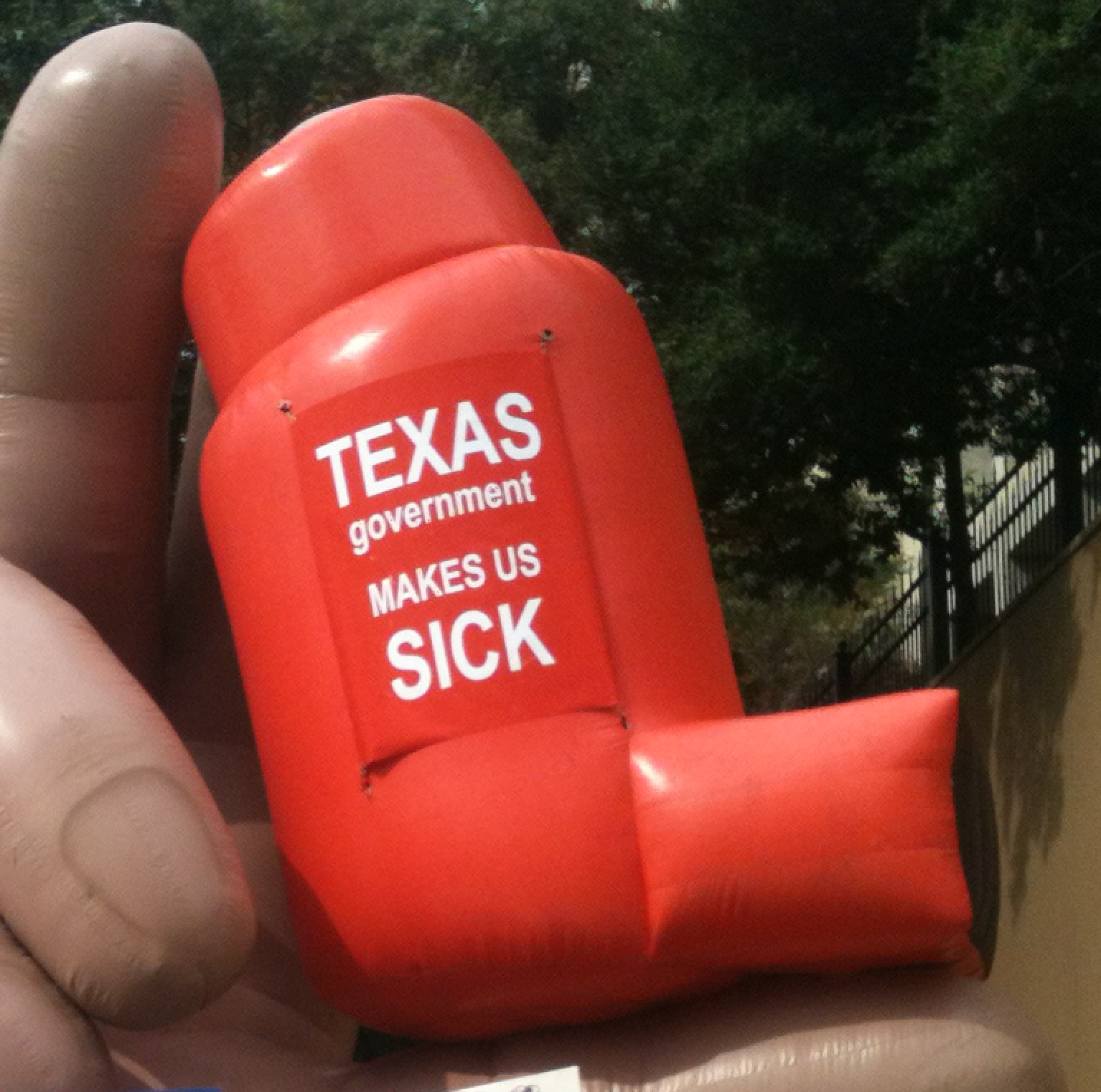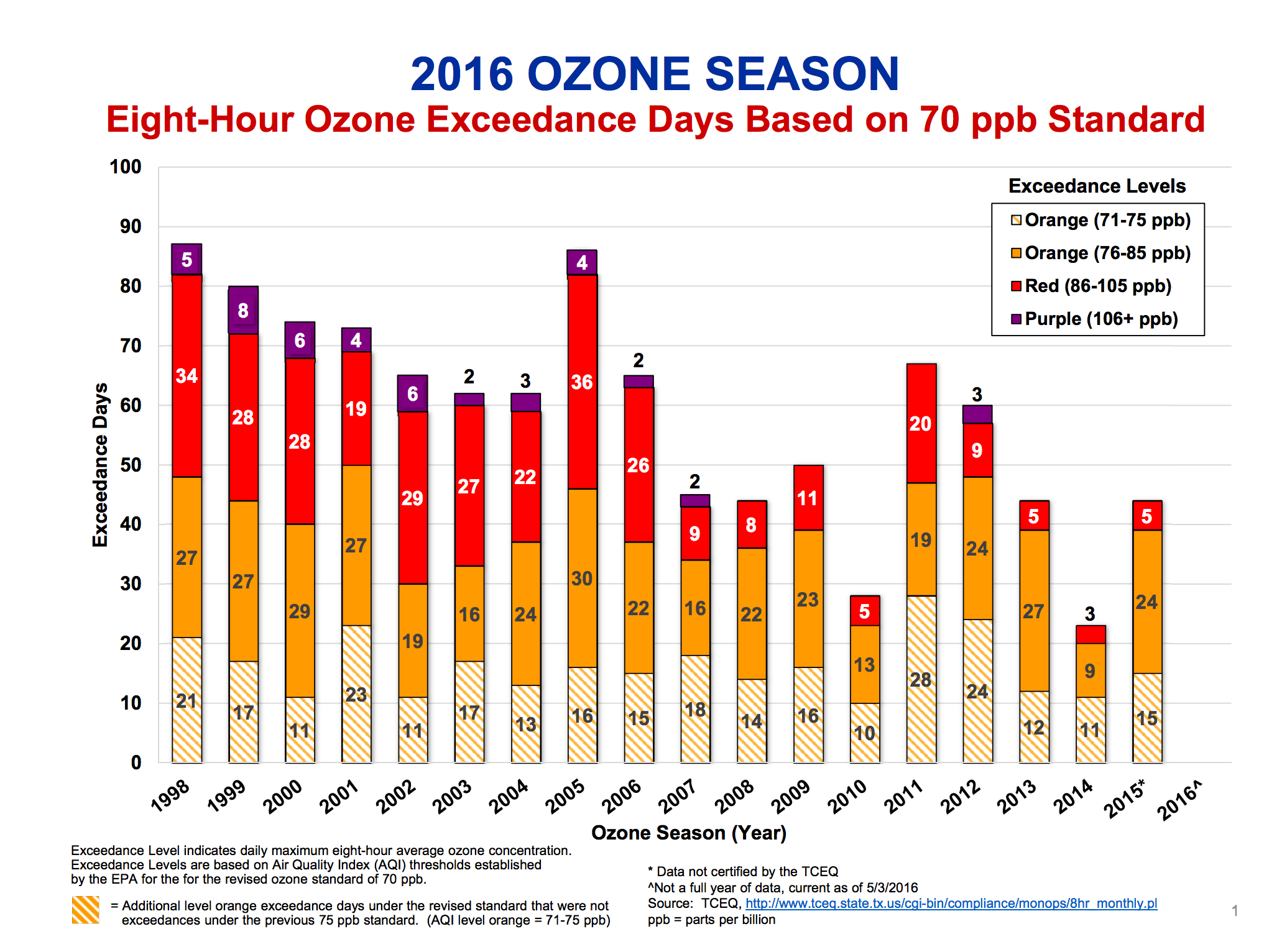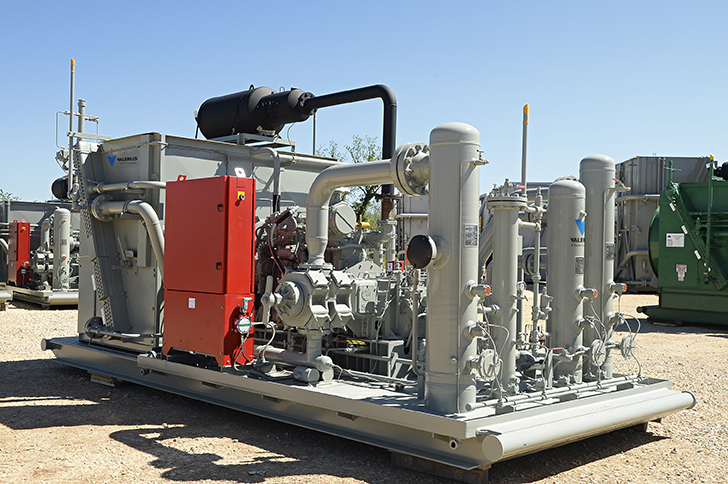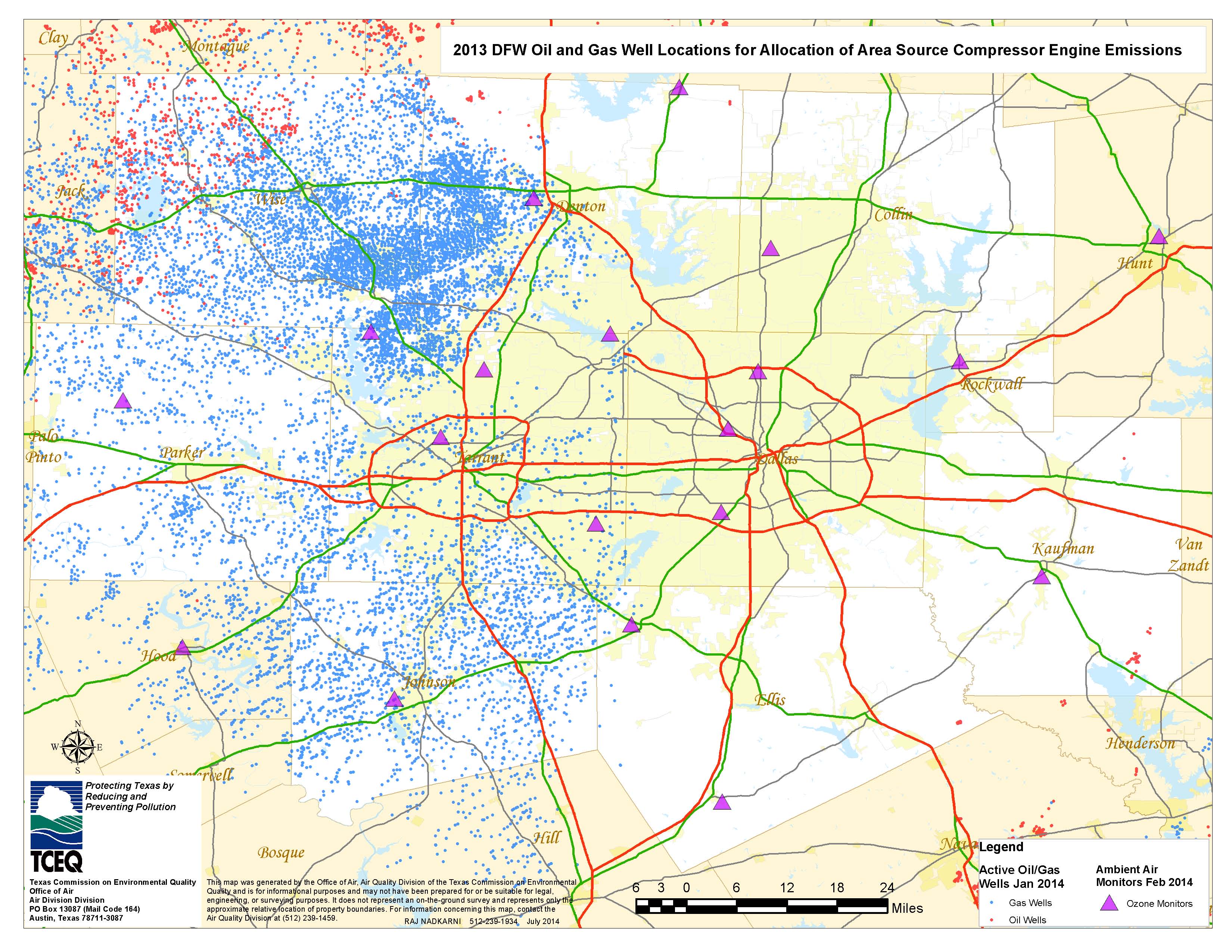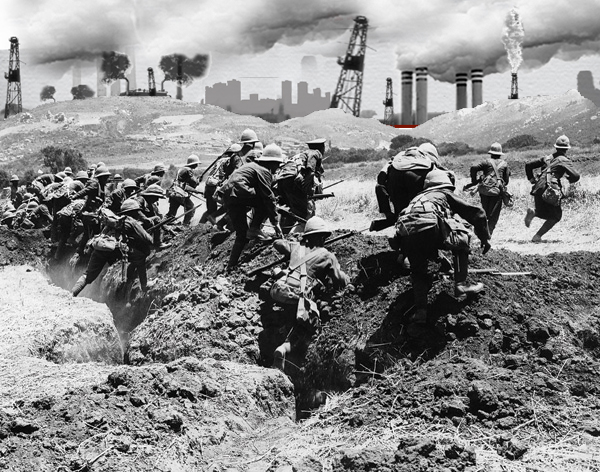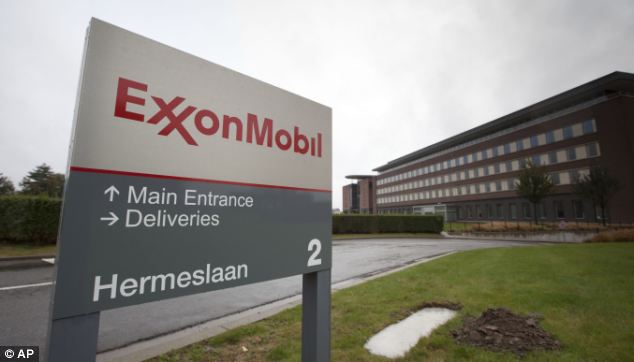Citizen Action
We Have A Fight On Our Hands: Luminant Said To Be Trying to Scuttle Dallas Clean Air Resolution With Dallas Chamber Help
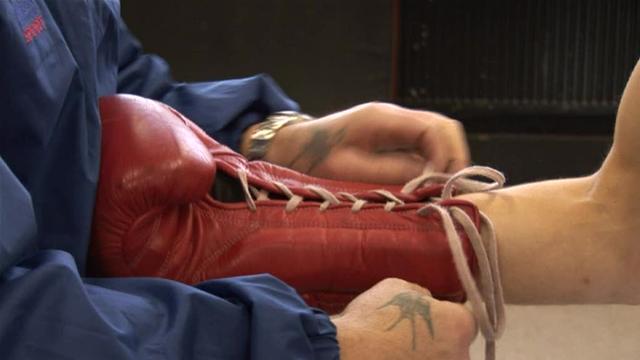 Only 48 hours after the single worst day for DFW smog since 2013, coal plant operator Luminant reportedly began a lobbying campaign to scuttle Sandy Greyson's Dallas city council clean air resolution requesting a better anti-smog plan.
Only 48 hours after the single worst day for DFW smog since 2013, coal plant operator Luminant reportedly began a lobbying campaign to scuttle Sandy Greyson's Dallas city council clean air resolution requesting a better anti-smog plan.
As a result, Item #12 “A resolution authorizing the City of Dallas to communicate its positions and requests regarding the Texas Commission on Environmental Quality's (TCEQ's) proposed State Implementation Plan for the Dallas-Fort Worth Region ozone pollution to the State of Texas, the TCEQ, and other agencies” is expected to be pulled from Wednesday’s unanimous voice-vote “consent agenda” and placed in line with other items generating discussion and dissent. It may be a long day – and that's exactly what the resolution opponents want in order to wear us down.
Luminant was said to be contacting city council members over the weekend, reportedly with the assistance of representatives of the Dallas Chamber of Commerce. In the past the company has stated it objects to the costs of installing the kind of modern anti-smog controls, referenced by the city’s resolution, at its three aging East Texas coal plants, despite their large smog-causing emissions. We don't know how successful the company's lobbying has been, or how much trouble the resolution is in.
If you're mad about this news, good. Here's what we need you to do:
1. If you haven't already, please follow this link and send a "click and send" ready-to-go email to all 15 Dallas city council members urging them to vote for the clean air resolution. You can add your own language at the bottom if you want.
2. Please sign up to speak in favor of clean air and the resolution on Wednesday
You must call the City Secretary''s office at 214-670-3738 to reserve a 3 minute speaking slot. Make sure you sign up for Item #12 on the consent agenda. If you don't sign-up in advance, you won't get to speak up on Wednesday!
We need to be there beginning at 9am, but we don't know how soon the resolution will come up in the agenda now. We know this makes it inconvenient. Again – not by accident. We've outlasted them before. We need to do it again.
3. Emphasize these Talking Points in your emails and speaking on Wednesday
-
All the air pollution control measures referenced in the city's clean air resolution are currently available, off-the-shelf technology, already in use in the world, US, and even Texas. Nothing exotic. Nothing experimental. There are coal plants and cement kilns with catalytic converters. There are already electric compressors. The resolution says only that the state should consider applying these technologies uniformly – to ALL major industrial sources affecting DFW air quality.
-
All the air pollution measures referenced in the city's clean air resolution are among the most cost-effective that can be taken, costing a small fraction of other measures already adopted. Putting controls on the coal plans and kilns costs $2-3,000 per ton of smog-forming pollution removed vs state programs spending $10-13,000 per ton. It's cheaper to prevent pollution at a dozen or so smokestacks than millions of tailipipes.
-
Most smaller Dallas businesses are already heavily-regulated for emissions because they're located within the DFW "non-attainment area," for smog, while the East Texas coal plants creating a huge chunk of that smog continue to be exempt from the same kind of regulations because they're located 90-100 miles outside the non-attainment area. They have more impact, but less regulation. That's not fair to Dallas-based businesses, or DFW''s seven million residents. We need small business owners to say the Chamber and Luminant doesn't speak for all of the Dallas business community.
-
The costs of installing new controls are small compared to the economic and public health costs of not installing them. Dr. Robert Haley's recent study for the Dallas County Medical Society concluded a drop of just 5 ppb in North Texas smog levels could save $650,000,000 in lost economic growth, and prevent hundreds of ER admissions, and 100 premature deaths – EVERY YEAR.
-
Luminant is taking the position that their three old coal plants are more important than the health of 1.2 million Dallas residents, and the other 5.5 million DFW citizens who breathe dirty air. The company is asking the Dallas City Council to place its interests above everyone else's.
-
DFW has been in continual violation of the Clean Air Act for smog since 1991. Our childhood asthma rates are higher than the state OR national average. EPA has already said the current plan doesn't do enough to lower smog levels to meet the federal standard. But opponents of the resolution have no alternative. They want the City of Dallas to sit on its hands and do nothing about 25 years of chronic smog – no matter how many people are affected by bad air. Does the City of Dallas really want to send the message that it doesn't care about clean air only a week before it hosts its own "Clean AIr Action Day" event at City Hall Plaza next Friday?
Some critics of these resolutions have argued they're only symbolic requests for cleaner air, and don't mean that much, or carry that much weight. If Luminant's reported response is any indication, it thinks this resolution is a threat to plans to sell-off those aging coal plants as part of its parent company's bankruptcy. We must be doing something right to engender this kind of alleged opposition from North Texas' King of Coal.
DON'T LET BIG COAL WIN THIS FIGHT
SPEAK UP IN SUPPORT OF CLEAN AIR – Call the City Secretary and Register to speak on Wednesday
THIS WEDNESDAY, JUNE 15th
9 AM DALLAS CITY HALL 1500 MARILLA
Dallas Council Committee Votes for Air Quality Resolution, Heads for Full Council Vote in June
SEND A "CLICK N SEND" EMAIL TO ALL 15 DALLAS CITY COUNCIL MEMBERS URGING THEM TO VOTE FOR CLEANER AIR IN JUNE
By a vote of 5 to 1 the City of Dallas moved closer to joining Dallas County in repudiating the State's do-nothing DFW clean air plan and demanding something better.
It was the second vote in less than a month to condemn an anti-smog strategy the Texas Commission on Environmental Quality claims gets DFW "close enough" to the current federal standard, but is criticized by clean air advocates as inadequate to end the region's chronic bad air problem.
In April U.S. Congressional Representatives Eddie Bernice Johnson and Marc Veasey asked the EPA to reject the State plan and write its own.
Council members Mark Clayton, Philip Kingston, Tiffini Young, and Rickey Callahan backed a wide-ranging air quality resolution sponsored by Quality of Life Committee Chair Sandy Greyson. Casting the lone no vote was Adam McGough.
Greyson's resolution cites the EPA's conclusion "that the latest air quality State Implementation Plan (SIP) proposed by the Texas Commission on Environmental Quality (TCEQ) is not adequate to address the (the region's) ozone concentrations"
One reason given for the inadequacy is the plan doesn't touch major sources of air pollution affecting DFW including the East Texas coal plants, the Midlothian cement kilns and oil and gas facilities. The resolution specifically requests the state to follow the prescription laid out by UNT's landmark 2015 DFW ozone study, itself based on the State's own computer air model by adding off-the shelf control technology to those industrial sources.
Besides rejecting the state's plan, the resolution also takes issue with the State's assertion that lowering smog levels won't improve public health by specifically adding a provision stating "…studies have shown a direct correlation between health issues, such as asthma and chronic obstructive pulmonary disease, and higher levels of ozone…"
It also calls for more renewable energy, net metering and an endorsement of the Obama Administration's Clean Power Plan – a 2016 Dallas Omnibus Air Quality resolution.
Nobody had anything nice to say about the Texas Commission on Environmental Quality, and Councilman Philip Kingston was particularly pointed in his criticisms. During a discussion about Dallas taking on some of TCEQ's enforcement duties, Kingston explained why the City preferred to to it themselves, rather than leave it up to the State: "Because they do the same thing with that responsibility as they do with all their responsibilities – they ignore them." Amen.
The resolution now goes to the full Dallas City Council for a final vote at one of two meetings before the summer break – either June 15th or June 22nd. Stay tuned for details.
Meanwhile, RIGHT NOW – you can send a quick e-mail toall 15 Dallas City Council members asking them to vote for the Greyson air quality resolution when it shows up on their doorstep. You can add a message of your own if you want.
Why a small variance could mean a big increase in DFW smog
Thousands of gas wells, pipelines, storage tanks, compressors, and other pieces of infrastructure in oil and gas patches, which individually don't emit the huge volumes of air pollution coming from a single cement kiln or a coal plant can, when combined, easily total tonnage larger than both.
And that's what has happened in DFW over the last decade. As the Barnett Shale boom crept further into the region's "non-attainment" area" for smog, all the air pollution from all those thousands of individual sources begin adding up and having an impact on air quality.
While other large sources were actually decreasing their pollution, the oil and gas sector was going the opposite direction. It ballooned. To the point where it's now the fourth largest category of air pollution in that "non-attainment area." The three sources that outrank it? 1. All vehicles on the road. 2. All vehicles off-the-road, and, 3."area sources" a catch-all term including everything from backyard BBQs to small paint shops, and probably some oil and gas sources itself. Oil and Gas air pollution is, by volume, now the largest source of industrial air pollution in the North Texas area, exceeding the Midlothian cement kilns, local power plants (now all gas-fired), and large manufacturing plants like the GM truck and SUV factory in Arlington. Only the East Texas coal plants emit more and their 90-100 miles outside the nonattainment boundary (another problem that needs fixing).
At the same time oil and gas air pollution rose from Barnett Shale development, DFW smog levels, which had been declining, began to plateau. For a decade now the annual smog average has hovered on either side of 85 parts per billion (ppb) – the obsolete 1997 standard that we were supposed to reach in the early Oughts. We were at 86 ppb of smog in 2008 and we're now at 83 ppb.
Look at the chart below, generated by the North Texas Council of Governments. In 2007 DFW had 45 "exceedence days". In 2015, DFW had 44 "exceedence days." There's a very good case to be made that oil and gas air pollution has prevented DFW from making the kind of air quality progress it might have otherwise made without that burden.
For the last five years, the State of Texas has been on a mission to deny any link at all between the oil and gas industry in the Barnett Shale and DFW smog. It's gone out of its way to hide the real volumes of pollution emitted by these sources, as well as avoiding or downplaying the significance to regional air quality of decreases in that pollution. That's not hyperbole, it's the record.
In looking ahead with its proposed DFW air plan now in the pipeline, the State has predicted that a drop in the number of new wells in the Shale will equal a drop in the amount of air pollution coming from O&G sources. Sounds logical doesn't it? Yet the industry's own text books say that it ain't necessarily so.
A drop in new wells is the tip of the O&G iceberg in DFW. Just because there were no new wells drilled last month doesn't mean there's no new pollution being released this month. Some 20,000 wells, almost 1000 large compressors, untold thousands of smaller compressors, millions of gallons of storage capacity, miles of pipelines – these all continue to operate and emit huge amounts of air pollution 24/7.
And when production-per-well drops, and the densest parts of the patch begin to play out, as is occurring now in the Barnett, investors don't usually go with the flow. They want to increase the flow. And so they install more "lift compressors" to squeeze every last molecule of gas they can out of a well. These compressors, powered by gas or diesel, increase air pollution. Not by a lot by themselves, but when you start putting them together, by the thousands, then yeah, they have an impact. And so, even when O&G production is declining, you can have increases in O&G air pollution.
Downwinders at Risk and the Sierra Club made this argument in our comments about the state's plan, providing sources from industry to show exactly how this has taken place plenty of times before. We told Austin it was underestimating the impact of O&G air pollution – again. The State dismissed our concerns and said no problem.
Which brings us to Mansfield in Tarrant County, scene of the last pre-HB40 gas ordinance fight in the state.
Last week, there was a small headline in the Fort Worth Star-Telegram a lot of people probably ignored. It concerned a routine variance to zoning code being requested by (notorious) gas well operator EagleRidge. At issue was whether the company could keep using gas powered lift compressors instead of electric-powered ones as the city's year-old ordinance required. EagleRidge made an argument in favor of the variance which sounded very familiar to some of us….
EagleRidge first noticed a dramatic decline in natural gas production at 15 of its wells last year, as it went from 8 million to 2.5 million cubic feet of natural gas per day. Low natural gas prices, trading about $2.10 per British thermal unit Monday, could make the wells economically unfeasible, according to Mark Grawe, executive vice president of EagleRidge.
That prompted EagleRidge to try a new strategy, using small gas lift compressors that increase production on the wells. Last year, Mansfield granted a six-month variance to allow the compressors on a trial basis.
Grawe said the compressors have already improved production on three of the wells, but addition tests are needed on EagleRidge’s other wells.
Eagle Ridge got its variance. And besides the three lift compressors it's operating on the site now, at least two to three more or expected, and all of those might one day be replaced by two giant-sized compressors. And, Eagle Ridge told the council, it's experience in Mansfield will be repeated at "hundreds of wells in Southeast Tarrant County" that have also seen declining production.
Eagle Ridge's ratio was approximately one lift compressor for every two wells. There are 15 wells as part of this one variance, "hundreds" in SE. Tarrant County waiting their turn, and 20,000 more throughout the part of the Barnett Shale in the DFW non-attainment area for smog. That's thousands and thousands more lift compressors emitting lots more air pollution even as Barnett Shale production is declining – and most will be located in cities or counties where there's not even a requirement for electric power to get a variance from. In other words, this is exactly the scenario Downwinders and the Sierra Club warned about in their comments, but which the state dismissed.
That's in addtion to the thousands of lift compressors already located in DFW, the exact number and location of which are unknown to EPA and Texas because they don't require indivdual permits. Austin "estimates" the total amount by using, you guessed it, production numbers. Here'a map from the Texas Commission on Environmental Quality guestimating where all those existing lift compressors are now:
If you think there might be a correlation between O&G pollution and stagnating DFW smog levels, what's the answer? It's pretty straight-forward. Stricter emission standards for all equipment, leak detection, electrification of large and small compressors. These are all things the industry is either doing in fits and starts in North Texas and elsewhere, or being required by the new EPA methane rules, but they're not being applied across the board in the Barnett Shale, or they don't apply to existing facilities, or both.
Who's going to make that happen? Local governments were doing some of it – up until the passage of HB40. For example, Dallas, Mansfield, and other cities required electric-powered compressors and state-of-the-art leak detection. But that's off the table, as is any action from Austin. That leaves the EPA as the one regulatory entity that could, if it wanted, impose uniform emission standards on all O&G facilities in the 10-county non-attainment area, including Denton, Johnson, Parker, Tarrant, and Wise counties. It could do so as part of it's own anti-smog plan for the region.
But before it can start writing its own plan, the EPA must first reject the state's. And for it to do that we must give the EPA the political support it needs to stand up to the backlash from Austin you know will come. Thus the need for resolutions from DFW cities and counties asking the EPA to reject the State plan. Thus the need to show-up this coming Monday morning at City Hall and support an effort by Dallas City Councilwoman Sandy Greyson to have the City of Dallas join Dallas County in calling for EPA intervention in DFW air quality: 9am Room 6ES, Quality of Life Committee.
Don't let the Mansfield variance become the regional template.
Next Week: Two Events Put DFW Greens on the Front Lines of Change…Again
GET OUT OF YOUR RUT AND JOIN THE FIGHT!
MONDAY, MAY 23rd
9am Dallas City Hall
1500 Marilla Downtown Dallas
Room 6ES (6th Floor, South)
Dallas City Council's Quality of Life Committee Considers/Votes
on the DFW AIR QUALITY RESOLUTION
WEDNESDAY, MAY 25th
7:30 am – 10 am
Morton Meyerson Symphony Center
2301 Flora Downtown Dallas
EXXON – MOBIL SHAREHOLDERS MEETING
MONDAY, the 23rd
Dallas could follow Dallas County and be the second North Texas local government to say they want the EPA to reject the state's air plan for DFW.
Think about that. In "Red" Texas, local governments are asking the EPA to intervene and give them cleaner air because of their own State's failure to do so.
Just like our Green Cement Campaign, and our Dallas Drilling Ordinance, an EPA- written air plan for DFW would be setting an important national precedent from right here in the Belly of the Beast.
 Sandy Greyson is Chair of this Committee, which includes:
Sandy Greyson is Chair of this Committee, which includes:
Tiffini Young
district7@dallascityhall.com
Mark Clayton
mark.clayton@dallascityhall.com
Philip Kingston
Philip.Kingston@dallascityhall.com
Adam McGough
adam.mcgough@dallascityhall.com
Rickey Callahan
rick.callahan@dallascityhall.com
Please email these council members and tell them you support Ms. Greyson's air quality resolution.
This is a Committee hearing. There is no public comment allowed, but public shows of support are encouraged and the council members may ask questions from experts in the audience.
We'll have plenty of DFW CAN BREATHE CLEAN AIR lapel pins. Feel free to wear one and/or show your support through other means.
If this Committee votes in favor of the resolution, it'll probably go to the full council for a vote in June.
Show up Monday and let the City Council know you care about clean air.
WEDNESDAY, MAY 25th
The national spotlight will be on Dallas again on Wednesday as Exxon-Mobil, our own hometown corporate Poster Child for climate change denial, will be holding its annual shareholders meeting in downtown Dallas.
Because of new revelations the company secretly knew about the dangers of climate change in the late 1970's, but continued to publicly deny the phenomenon, this year's annual meeting in Dallas is especially important. More than 500,000 people across the United States have called on the Department of Justice and State Attorneys General to look into Exxon's cover-up. So far, Massachusetts, U.S. Virgin Islands, New York, and California have launched official investigations.
350.org, the Sierra Club and other national groups have been leading the call to show up at the Exxon-Mobil meeting and make sure the company is held accountable for its past and current behavior.
Most of us never get to go to international conferences and protests like Paris last year, or even ones in DC or New York. But next Wednesday the 25th, the epic global fight against self-destruction comes to your own doorstep.
What are you going to do?
Don't let your activism end once you go off-line. Turn your "like" into an action.
Show up Wednesday morning bright and early and represent.
They'll be coffee and food. They'll be banners. They'll be media.
But we need you to be there too.
Help us show the rest of the world that we can do our part.
Help us keep the pressure on.
Help us win.
WEDNESDAY, MAY 25th 7:30 am – 10 am
Morton Meyerson Symphony Center 2301 Flora Downtown Dallas
Dallas County Votes to Reject State Air Plan, Asks EPA for Help
 By a vote of 3 to 2 this morning Dallas County became the first local government in DFW to take a stance rejecting the state-sponsored anti-smog plan for the area, and ask EPA for help in writing a new one that might actually produce cleaner air.
By a vote of 3 to 2 this morning Dallas County became the first local government in DFW to take a stance rejecting the state-sponsored anti-smog plan for the area, and ask EPA for help in writing a new one that might actually produce cleaner air.
At stake is the last comprehensive chance to address chronic smog in North Texas until the next decade.
Pct 1 Commissioner Dr. Theresa Daniel introduced the resolution. It garnered support from Dallas County Judge Clay Jenkins and Pct 4 Commissioner Elba Garcia.
One-by-one Judge Jenkins cited, and then shot down, arguments he said he'd heard from industry about East Texas jobs, electric grid reliability, and the "premature" nature of the vote, given that the state's plan doesn't officially arrive at the EPA's doorstep until July. He said he found none of these persuasive in light of the impact to public health and lost productivity from dirty air days in Dallas County cited in Dr. Robert Haley's landmark 2015 study on the costs of smog in DFW. And he saw no indication the state was planning to change anything in the plan prior to July's official submission.
Garcia was hopeful that the measure, although without the weight of law, would still be effective in getting the EPA to provide a more effective clean air plan.
Daniel cited the fact the area has continually been out of compliance with the Clean Air Act since 1991 despite five previous state air plans as evidence of something more being needed this time around. She also reminded the Court of the conclusions of the UNT's ozone study, based on the state's own computer air modeling, showing the East Texas coal plants to be the single biggest influence on DFW smog.
Commissioner John Wiley Price, facing federal corruption charges, gave perhaps the most puzzling and incoherent defense of dirty air ever heard inside a local governmental chamber. He seemed to be adopting the TCEQ party line in arguing that the coal plants weren't impacting DFW air and the Court's actions were "premature" – he latched on to Jenkins phrase like a drowning man to a floating log. But honestly, there weren't a lot of complete sentences to his explanation. Which is a shame, because when you talk about who pays the price for dirty air in Dallas County, a disproportional number of those casualties are Commissioner Price's constituents – people of color who make less than the median income. They need a strong advocate for clean air, not a rambling echo chamber for the failed status quo.
Commissioner Mike Cantrell, the lone Republican on the court, did not speak at all. Such is the state of the Texas Republican Party.
Dallas County's resolution now goes to EPA, will it will join a letter sent two weeks ago by Dallas area congressional representatives Eddie Bernice Johnson and Marc Veasey, which also requested EPA reject the state's plan and write one of its own if it has to.
Meanwhile, clean air advocates are fanning out and seeking appointments with representatives from other North Texas counties and cities to attempt to get as many similar resolutions as they can between now and the end of the year, when a final decision could be made by EPA to accept or reject the plan. They say the more local governments that pass them, the more likely it is EPA will feel it has the political support to intervene.
Because Dallas District 12 Councilwoman Sandy Greyson served with Commissioner Daniel on the same committee overseeing the UNT and Haley studies, it's probable Dallas City Hall will be one of the next front lines in this fight. Stay tuned.
Join Us for the First DFW Air Quality Vote of 2016
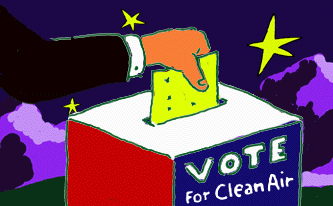 Dallas County Commissioners' vote on sending state air plan back to Austin:
Dallas County Commissioners' vote on sending state air plan back to Austin:
This Tuesday, May 3rd, 9 am 411 Elm Downtown Dallas
First air quality vote of 2016
Come help us thank local officials for standing up to the state
This next Tuesday, May 3rd, the Dallas County Commissioners Court will hold an historic vote.
Commissioners will be asked to go on record as the first local North Texas government urging the EPA to reject the currently proposed state air plan for DFW and replace it with a stronger one that actually cuts pollution.
Pct. 1 Commissioner Theresa Daniel is sponsoring a resolution that requests EPA to do two things:
"…to reject the proposed State Implementation Plan for DFW ozone pollution, and require a new federal DFW clean air plan that can meet or exceed the current 75 ppb federal ozone standard at all North Texas monitoring sites, and implement all reasonably available pollution controls as defined by the federal Clean Air Act.
and
"...regulate East Texas coal plants as if they were in the DFW non-attainment area, or include them in a larger non-attainment area for North Texas under rules governing the new federal 70 ppb ozone standard."
As the most populous county in the 10-County DFW "non-attainment area" for smog, Dallas carries a lot of political weight. Passing such a resolution would be an important signal to other local officials concerned about the two-decade plus chronic air pollution problem in the region.
Downwinders and other citizens groups have formed a new ad-hoc alliance to campaign for similar resolutions in other North Texas cities and counties as part of a broader effort of convincing EPA to replace another state "do-nothing" air plan with one of its own.
The DFW Clean Air Network, or DFW CAN, includes the Dallas Sierra Club, and the Sierra Club's Beyond Coal campaign,Public Citizen Texas, Mansfield Gas Well Awareness, Liveable Arlington, and Texas Campaign for the Environment.
It's important to recognize what a challenge Commissioner Daniel and others are facing in taking on Austin over this issue. They need to see your support for their brave stands. And all the Dallas County Commissioners need to be reminded how long we've had to breathe dirty air and why we're fed-up with the state's apathy.
We CAN win this vote.
We CAN make a difference.
We CAN breathe clean air.
Downwinders’ Drone Air Monitoring Project Makes Finals of “Earth Tank Prize” Competition
 In what would be a huge leap forward in the ability of citizens to do their own air monitoring, Downwinders' proposal to purchase a drone and use it for regional air quality sampling is in the running for Earth Day Texas' "Earth Tank Prize" competition.
In what would be a huge leap forward in the ability of citizens to do their own air monitoring, Downwinders' proposal to purchase a drone and use it for regional air quality sampling is in the running for Earth Day Texas' "Earth Tank Prize" competition.
Purchasing the first aircraft in a new citizen-organized "North Texas Clean Air Force" is now one of nine projects to be pitched live in front of a "Shark Tank"- like atmosphere of audience and judges on the last day of the Fair Park extravaganza. Locally-based Downwinders' is in direct competition with two other groups in the category of organizations with budgets under $100,000 annually: statewide group Texas Campaign for the Environment, and Austin-based Rainforest Partnership. The prize is a $3000 grant.
Earth Tank Prize 2016 is an initiative of Earth Day Texas (EDTx) and Dallas Festival of Ideas (DFOI) that awards cash prizes to environmental non-profit groups for important conservation and sustainability projects in Texas. The other two categories of contestants – non-profits making between $100-500,000, and those bringing in over $500,000 also have three finalists each and are competing for prize packages of $7,000 and $15,000 respectively. The complete list of finalists is here.
For our own effort, Downwinders has partnered with Dr. Michael Slattery of TCU's Institute for Environmental Studies, who has experience in both air quality modeling and using drones for conservation of rhino populations in Africa. Dr. Slattery would head a committee determining the use of the drone to insure scientific credibility and useful, robust data. Local academic institutions and non-profits would be able to propose projects that would be weighed on their ability to add to public policy and public health.
Besides its capacity to provide a new tool for researchers, the Downwinders' drone could also become an important enforcement tool for citizens.
Having the ability to monitor and sample air quality in real time anywhere in the North Texas area is a game changer for local public health policy. Not only can a wide variety of hypotheses be tested relating to plume transport and content, but you’d have the ability to monitor downwind of catastrophic accidents, and confirm the compliance of major polluters. You can show where the state should place new official monitors, and what pollutants those monitors should be targeting. You can map more effective control strategies using the results.
As we noted in our submission, what’s unique about this proposal is not that it employs a drone, but that it’s a direct assumption of government responsibilities by local citizens and experts. Much like Downwinders' recent taking over of the state's air computer modeling duties for smog, churning out a map for cleaner air the state could not bring itself to produce, this is a way that citizens can not just supplement, or replace the state's current air monitoring and sampling program. We can build a better one.
All nine finalists for the Earth Tank Prize will pitch live to an audience and judges at Fair Park Sunday, April 24th. We'll follow-up with details as to when and where. Cross your fingers.
Bring the East Texas Coal Plants into DFW’s Smog “Non-Attainment Area” and See How Long They Last……
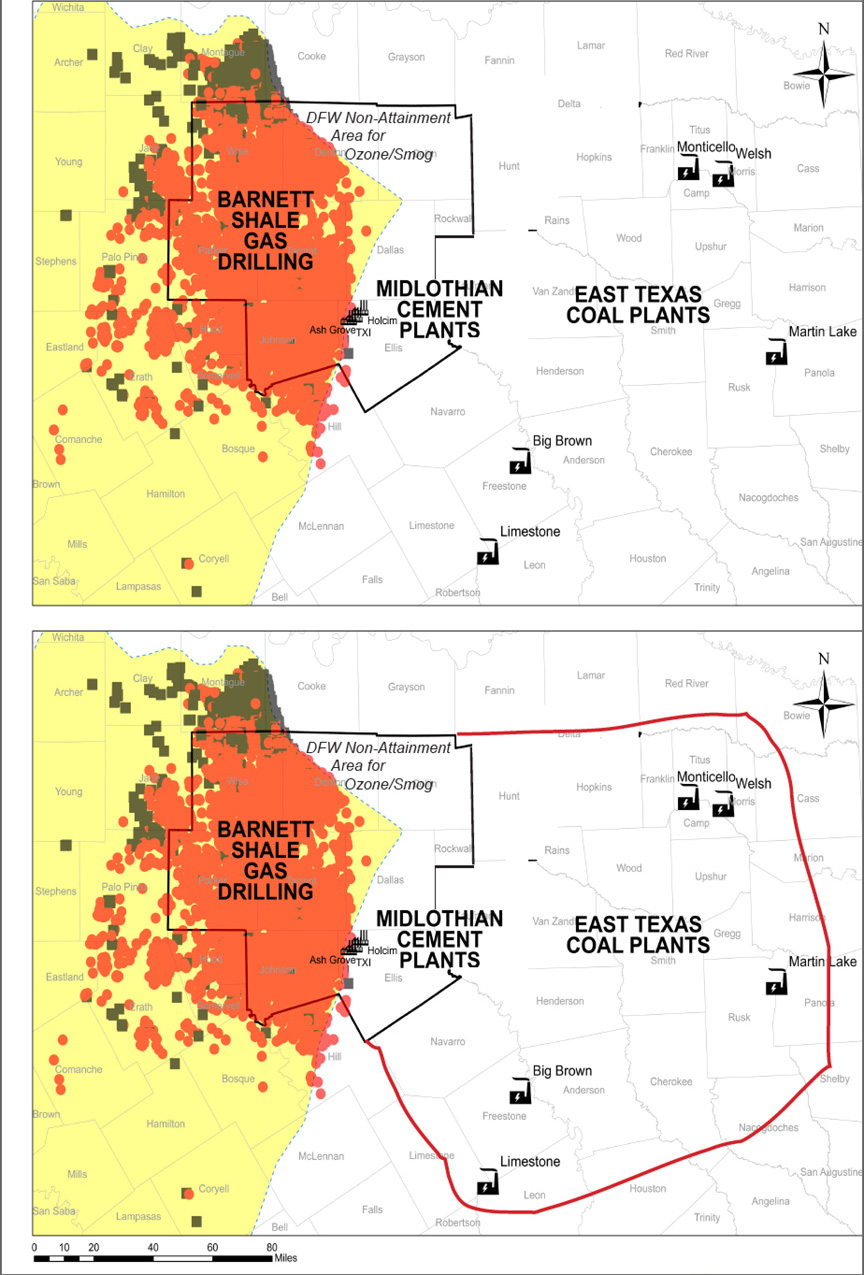 Want the Coal Plants to Face the Kind of Regulation
Want the Coal Plants to Face the Kind of Regulation
They've Been Avoiding for Decades?
Click here and send a formal comment letter demanding the coal plants
be included in the new DFW non-attainment area for smog.
Even as we're all waiting to see what EPA decides to do about the current Texas air plan for DFW under the current 75 ppb ozone standard, the regulatory process is gearing-up to administer the new 70 ppb standard.
One of the things which must be decided by the EPA are what geographical boundaries to use for the new standard when it comes to the DFW airshed and its chronic smog condition. Should they stick with the current 10-County configuration or should it be different and/or more inclusive?
The history of DFW's smog fight is a lengthy chronicle of bringing new counties into the fold despite official resistance. Originally, the DFW non-attainment area was only Tarrant, Dallas, Collin and Denton. Then Rockwall, Parker, and Johnson Counties came in because of their commuter traffic.
Downwinders had to petition the EPA to bring Ellis County and its cement industrial complex into the non-attainment area early in this century after being told repeatedly by state officials that its pollution had no impact on DFW air quality.
More recently, the state argued against the inclusion of Wise County, despite its huge inventory of oil and gas pollution, population of commuters, and more than likely, the highest ozone levels of anywhere in North Texas. EPA decided to bring it in anyway.
We're once again at a crossroads, and it could be the most significant one in a decade.
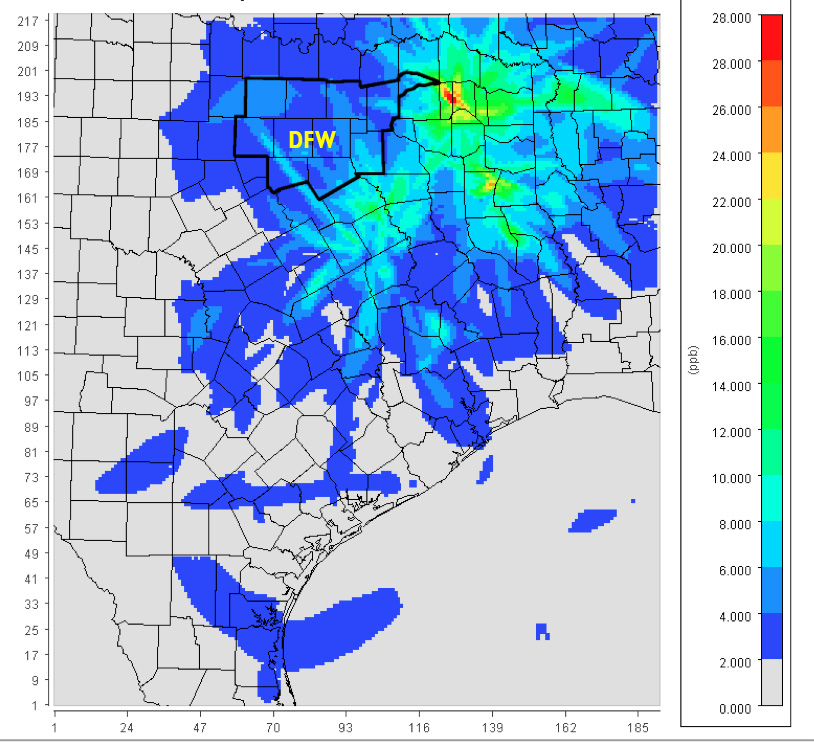 New evidence shows the huge impact the East Texas coal plants have on DFW air quality. Every scenario run by the UNT Engineering Department with the state's own DFW air computer model as part of Downwinder's Ozone Attainment Project demonstrates there's no more effective smog fighting strategy than reducing or eliminating the pollution from these coal plants.
New evidence shows the huge impact the East Texas coal plants have on DFW air quality. Every scenario run by the UNT Engineering Department with the state's own DFW air computer model as part of Downwinder's Ozone Attainment Project demonstrates there's no more effective smog fighting strategy than reducing or eliminating the pollution from these coal plants.
In fact, with a few other measures within the DFW area itself, controlling or eliminating their emissions could bring us in compliance with the 75 ppb standard, something that's not likely to happen otherwise.
Why is it so important to officially bring them into the DFW non-attainment area? Because major sources of pollution like coal plants are regulated differently inside than they are outside the area.
Right now, many DFW businesses are having to pay to operate and maintain pollution control equipment although most emit a tiny fraction of the pollution coming from the coal plants. That's because they're located in one of the ten counties in the DFW non-attainment area. They're held to a higher standard of control than their peers doing business outside those ten counties.
On the other hand, despite their large contribution to DFW's chronic ozone problem, the East Texas coal plants remain untouched by the same regulations and are not held to that higher standard. What sense does that make?
As much sense as it made to keep the cement plants out. As much sense as it made to try and exclude Wise County.
As per usual, the EPA is letting the state have first crack at defining a new DFW smog zone. The state has decided to leave the boundaries the way they are.
 Now, it's your turn to comment on that state decision, and tell Austin and the EPA – which will review the State's recommendations – what you think needs to happen.
Now, it's your turn to comment on that state decision, and tell Austin and the EPA – which will review the State's recommendations – what you think needs to happen.
The state is accepting comments on its decision until April 15th. This time, you can send your comments directly by e-mail instead of having to go through the official Texas Commission on Environmental Quality website
If you want to use our ready-to-send letter, all you have to do is CLICK HERE , sign the letter and add your own comments if you want. Then one more click and it's on it's way to Austin.
If you want to write your own comments:
EMAIL: kristin.patton@tceq.texas.gov
SNAIL MAIL: Kristin Patton, MC 206, State Implementation Plan Team, Office of Air, Texas Commission on Environmental Quality, P.O. Box 13087, Austin, Texas 78711-3087,
FAXED:(512) 239-6188.
All comments should reference "2015 Ozone NAAQS Designation Recommendations."
Lois Gibbs Is Offering You Money
 Many of you got a chance to meet and hang out with American grassroots legend Lois Gibbs during our Root and Branch Review last November. Now comes news that her Virginia-based Center for Environmental Health and Environmental Justice is opening up a new round of small grants for local groups.
Many of you got a chance to meet and hang out with American grassroots legend Lois Gibbs during our Root and Branch Review last November. Now comes news that her Virginia-based Center for Environmental Health and Environmental Justice is opening up a new round of small grants for local groups.
According to the Center's release, "grassroots communities of color, low wealth, faith based, rural and urban groups are encouraged to apply. This grant program will support projects that help groups move towards their goals by building leadership and/or the group’s capacity. These projects could include meetings to develop an organizing strategy plan, training events, educational activities or membership outreach. The grant awards will be uwith annual budgets of no more than $50,000.
CHEJ’s Small Grants Program helps grassroots, community organizing groups build their capacity. The program is designed to especially reach people from low wealth communities and communities of color who are impacted by environmental harms. Grant activities can include board development, membership outreach, and fundraising efforts. Project activities could also include meetings to develop an organizing strategic plan, training events, educational activities which are directly connected to your strategic plan, or membership recruitment. It is recommended that project activities be creative, effective and/or strategic."
Not an official 501c3 non-profit? Not a problem if you can find a friendly one to piggyback on as "a fiscal sponsor" to accpet the funds on your behalf.
Deadline for proposals is Friday, April 8th. The short two-page application can be downloaded here: Small Grants Outreach Letter Application 2. Any questions can be directed at the group via their email address, info@chej.org.
Good luck.
A Guide to the State’s War on the Clean Air Act
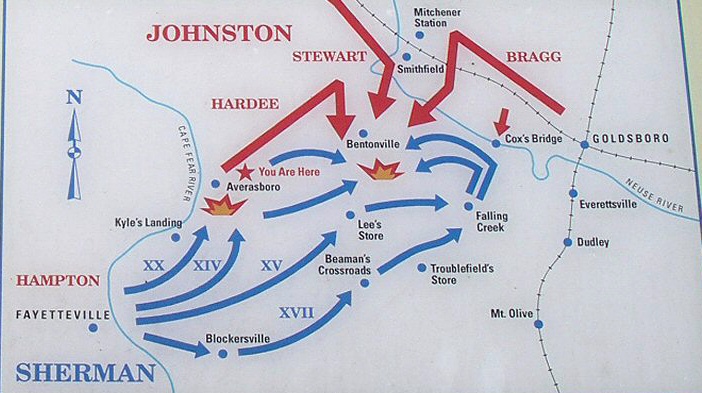 There's been a lot of activity lately on the many-fronted war the State of Texas is conducting against the Clean Air Act. What about a brief status report:
There's been a lot of activity lately on the many-fronted war the State of Texas is conducting against the Clean Air Act. What about a brief status report:
1) Mercury Rules
Thursday's headline was that Supreme Court Justice Roberts denied the attempt by Texas and 18 other states to delay the implementation of EPA's new, more protective limits on release of toxic Mercury pollution from coal plants. In 2013, three out of the top five largest Mercury polluters in the whole country were Texas coal plants.
It was only last summer that majority of the entire Court ruled EPA hadn't followed protocol in weighing costs to the coal industry versus public health benefits, and sent the standard back to the Agency to be rewritten. Not an especially big deal.
Texas, along with other states, sought an injunction from Justice Roberts to stop the timeline for implementation of the rules until the rewrite was finished. Roberts denied the request and so EPA is allowed to continue writing the rules and now expects to release the revised edition next month. One indication of how much trouble the rules are in, or not, is the speed and format of Robert's actions. He ruled on the case only a day after the EPA had submitted its brief, and ruled on it unilaterally, not bothering to convene the full Court.
The practical implications of the rules are reductions in the use of coal with higher Mercury content, better Particulate Matter pollution control equipment, and specific carbon absorption control technology aimed at Mercury. Many Texas coal plants have already taken steps to comply with the standards and it seems like almost all have applied for extensions to the original deadline.
2) Haze Rules
Earlier this week, Texas Attorney General Ken Paxton announced the state was suing the EPA for rejecting its lackadaisical plan to protect national parks from haze air pollution, also mostly coming from coal plants. Just three Luminant coal plants – Big Brown, Martin Lake and Monticello – release 40% of all Texas’ Sulfur Dioxide air pollution.
Late last year, EPA announced it found the state's lightning-fast 140-year plan to do absolutely nothing somehow inadequate, and begin to draft one of its own that would require "scrubbers" for Sulfur Dioxide pollution at nine coal plants across the state. It also concluded Texas had intentionally downplayed the impact of the coal plants on park air quality in computer modeling submitted to EPA .
Texas is suing to prevent the EPA from enforcing its plan to require scrubbers and asking the court to accept the original Texas plan as reasonable. Pending.
3) Sulfur Dioxide Non-attainment Areas in East Texas
In mid-February, EPA announced it intended to declare areas surrounding three East Texas coal plants as out of compliance with national Sulfur Dioxide pollution limits and declared them in official "non-attainment" of the Clean Air Act. Big Brown, Monticello, and Martin Lake power plants were found to be causing the violations in ambient air quality using computer modeling results first run by the Sierra Club, and then analyzed by the EPA. Boundaries were drawn for the new non-attainment areas that include all or parts of Freestone, Anderson, Rusk, Gregg, Panola, and Titus counties.
Final action by EPA on the non-attainment area classification is scheduled for this summer. Then it will be up to the state to submit a plan for action. We can all write the script from there. It ends in a court ruling.
Eventually, these East Texas non-attainment areas are another tool by EPA's to raise the costs of operating the oldest, most polluting coal plants to better reflect their toll on public health. Plants could lower their Sulfur Dioxide emissions by importing more "Cleaner Coal" from Wyoming and/or paying for those scrubbers the Haze Rules requires too.
4) DFW Clean Air Plan
DFW is in "non-attainment" for ozone, or smog pollution. It has been since 1991. The State has submitted a plan to EPA that sits back and watches federal fuel changes reduce smog-forming pollution by 20-40 tons per day. The problem? EPA estimates it will take cuts of 100-200 tons per day to get down to the current ozone standard of 75 parts per billion. The state says it sees no reason for more cuts.
This is the state plan up for comment at the the now infamous "F*** the TCEQ" public hearing in Arlington in late January, with final submission to EPA by the state this summer.
But between now and then one of the headlines you should see will be EPA rejecting the part of the state's plan dealing with pollution control technology. EPA has already telegraphed their intention to do so, and they don't have to wait for the state's final submittal deadline to act.
This will, of course, be followed by the state's suing the EPA for daring to enforce the Clean Air Act when Austin won't. But it won't keep the EPA from doing exactly what it did in the Haze Rule fight – write its own clean air plan for DFW.
And that will be our chance to make the greatest leap forward in local air quality in a decade.



